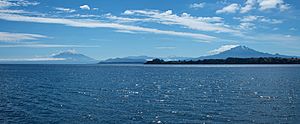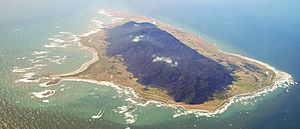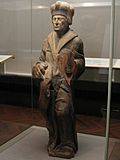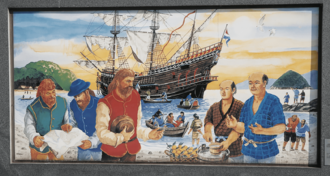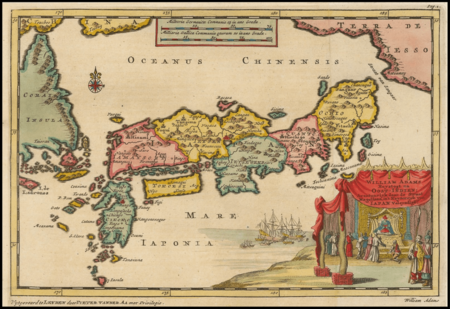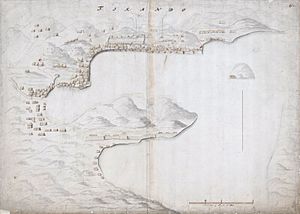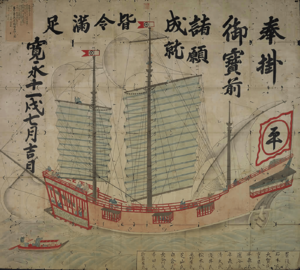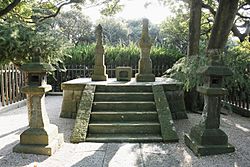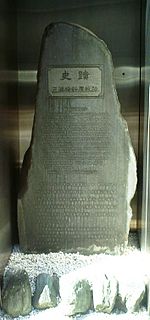William Adams (pilot) facts for kids
Quick facts for kids
William Adams
|
|
|---|---|
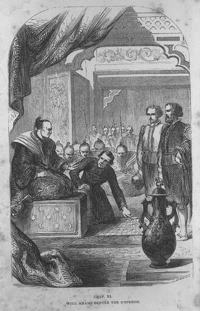
William Adams before Shogun Tokugawa Ieyasu
|
|
| Born | 24 September 1564 Gillingham, Kent, England
|
| Died | 16 May 1620 (aged 55) Hirado, Nagasaki Prefecture, Edo shogunate
|
| Resting place | William Adams Memorial Park, Sakigata Hill, Hirado, Nagasaki Prefecture, Japan |
| Nationality | English |
| Other names | Miura Anjin (三浦按針) |
| Citizenship | Japanese |
| Occupation | navigator |
| Known for |
|
| Title | Miura Anjin |
| Term | 1600–1620 |
| Successor | Joseph Adams |
| Spouse(s) |
Mary Hyn
(m. 1589)Oyuki
(m. 1613) |
| Children | John Adams (son) Deliverance Adams (daughter) Joseph Adams (son) Susanna Adams (daughter) |
William Adams (Japanese: ウヰリアム・アダムス, Hepburn: Wiriamu Adamusu) (born September 24, 1564 – died May 16, 1620) was an English sailor. He is better known in Japanese as Miura Anjin (三浦按針), which means "the pilot of Miura." In 1600, he became the first Englishman to reach Japan.
Adams arrived on a ship called de Liefde. It was the only ship left from a group of five sent by a Dutch company. Many crew members were sick or had died. Adams and his second mate, Jan Joosten, were not allowed to leave Japan.
Adams and Joosten settled in Japan. They became important advisors to the powerful leader, Tokugawa Ieyasu. Adams even helped build the first Western-style ships in Japan. He also played a big part in Japan's trade with other Asian countries. Adams died in Japan when he was 55 years old. He is remembered as one of the most important foreigners in Japan during that time.
Contents
- Early Life and Naval Service
- Journey to the Far East
- Crossing the Pacific
- Arrival in Japan
- Building Japan's First Western-Style Ships
- Becoming a Samurai
- Dutch and English Trading Posts
- Religious Conflicts
- Asian Trade Journeys
- Death and Family
- Honors and Legacy
- William Adams in Stories and Games
- Images for kids
- See also
William Adams was born in Gillingham, Kent, England. When he was twelve, his father passed away. He then began training to be a sailor and shipbuilder in Limehouse. For twelve years, he learned about building ships, studying the stars, and navigating the seas.
After his training, Adams joined the Royal Navy. England was at war with Spain. In 1588, he served in the navy against the Spanish Armada. This was a huge fleet of Spanish ships. Adams was the master of a resupply ship called the Richarde Dyffylde.
In 1589, Adams married Mary Hyn. They had two children, a son named John and a daughter named Deliverance. Later, Adams worked as a pilot for the Barbary Company. Some stories say he went on a two-year trip to the Arctic. He was looking for a northern sea route to Asia. However, Adams never mentioned this trip in his own letters.
Journey to the Far East
In 1598, when Adams was 34, he joined a Dutch trading trip. He became the chief pilot for a fleet of five ships heading to Asia. England and the Netherlands were allies at this time. Both were Protestant countries fighting against Spain.
Adams and his brother Thomas sailed from Texel, an island in the Netherlands. The fleet's main goal was to reach South America. They planned to sell their goods for silver there. If that failed, they would go to Japan for silver and then to the Moluccas for spices. The journey was very difficult. They had to sail through the Strait of Magellan, which was known for bad weather.
The five ships in the fleet were:
- The Hoope ("Hope")
- The Liefde ("Love" or "Charity")
- The Geloof ("Faith")
- The Trouw ("Loyalty")
- The Blijde Boodschap ("Good Tiding" or "The Gospel")
Many sailors got sick with diseases like scurvy. They also faced starvation. About 200 crew members died during the journey.
Crossing the Pacific
In September 1599, the ships finally reached the Pacific Ocean. But a big storm hit them, and they lost sight of each other. The Geloof was the only ship that made it back to the Netherlands.
The Hoope landed on Mocha Island, where 27 people were killed. William Adams' brother, Thomas, was among them. The Liefde also landed there but continued its journey.
William Adams had moved to the Liefde earlier in the voyage. This ship was originally named Erasmus and had a wooden carving of Desiderius Erasmus on its back. This statue is now in the Tokyo National Museum.
The remaining ships decided to sail across the Pacific Ocean. On November 27, 1599, the Liefde and another ship headed west towards Japan. During this long trip, a typhoon sank the Hoope with everyone on board.
Arrival in Japan
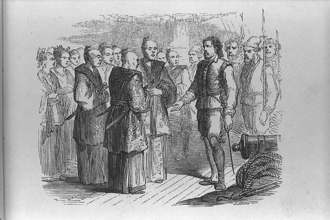
In April 1600, after more than 19 months at sea, the Liefde finally reached Japan. Only 23 sick and dying men were left from the original 100. They anchored off the island of Kyūshū. The ship carried goods like cloth, beads, mirrors, tools, and weapons. It had nineteen bronze cannons and 5,000 cannonballs.
When the nine strongest crew members went ashore, they met Japanese locals. Portuguese priests were also there. The priests claimed Adams' ship was a pirate vessel. They said the crew should be put to death. The ship was taken, and the sick crew was imprisoned. This was ordered by Tokugawa Ieyasu, a powerful lord who would soon become the shōgun. The cannons from the Liefde were later used in an important battle.
Adams met Ieyasu three times in Osaka. Ieyasu was very interested in Adams' knowledge of ships, shipbuilding, and math.

Ieyasu ordered the Liefde to be sailed to Edo. The ship was too old and damaged to be fixed, so it sank there.
Building Japan's First Western-Style Ships
In 1604, Tokugawa Ieyasu asked Adams and his crew to help build Japan's first Western-style ships. They worked with Mukai Shōgen, the navy commander. The first ship was 80 tons and built in Itō. It was used to explore the Japanese coast.
The next year, the shōgun ordered an even bigger ship, 120 tons. This was a bit smaller than the Liefde. Adams said Tokugawa was very pleased with it. In 1610, this 120-ton ship was loaned to Spanish sailors whose own ship had been wrecked. They sailed it to New Spain (modern-day Mexico).
After these ships were built, Tokugawa Ieyasu invited Adams to visit his palace anytime. He wanted Adams to be his advisor.
Other survivors of the Liefde were also given special treatment. They were allowed to trade with other countries. Most of them left Japan in 1605. However, Adams was not allowed to leave until 1613. Some of his shipmates, like Melchior van Santvoort and Jan Joosten, became very rich from trading between Japan and Southeast Asia.
In 1609, Adams helped Tokugawa Ieyasu contact the governor of the Philippines. Ieyasu wanted to start direct trade with New Spain. This led to friendly letters and official relations between Japan and New Spain. Adams also helped with Japan's "Red Seal" trade, which was special permission for ships to trade overseas.
Becoming a Samurai
Tokugawa Ieyasu liked Adams very much. He made Adams his advisor on Western countries and culture. Adams even became the shōgun's official interpreter. A priest named Valentim Carvalho said Adams "had access to Ieyasu and entered the palace at any time." He also called Adams "a great engineer and mathematician."
Adams had a wife and two children in England. But Ieyasu did not let him leave Japan. Instead, he gave Adams two swords, which were symbols of a Samurai. The shōgun declared that William Adams the pilot was "dead." In his place, Miura Anjin, a samurai, was "born." This meant Adams would serve the shogunate forever. Adams was able to send money to his family in England after 1613.
Adams was also given the title of hatamoto. This was a high-ranking position as a direct follower of the shōgun. He received a large estate in Hemi, near present-day Yokosuka City. This land was worth enough rice to feed 250 people for a year. Adams wrote that "God hath provided for me after my great misery," meaning his difficult journey to Japan.
Adams' estate was close to Uraga harbor, a main entrance to Tokyo Bay. He was known for dealing with goods from foreign ships there.
It is believed that William Adams had a child in Hirado with a Japanese woman. He married Oyuki, the adopted daughter of a highway official. They had a son named Joseph and a daughter named Susanna. Adams traveled often for his work.
Dutch and English Trading Posts

In 1604, Ieyasu sent the Liefde's captain, Jacob Quaeckernaeck, to Southeast Asia. He wanted them to contact the Dutch East India Company. This company had just started trading. Ieyasu wanted more Western trade in Japan to break the Portuguese monopoly. In 1605, Adams got a letter from Ieyasu inviting the Dutch to trade.
The Dutch could not send ships until 1609. Two Dutch ships arrived in Japan on July 2, 1609. They set up a trading base, or "factory," on Hirado Island. Adams helped them get free trading rights throughout Japan. The Portuguese, by contrast, could only sell their goods in Nagasaki at set prices.
The Dutch opened their trading factory in Hirado on September 20, 1609. They kept their "trade pass" for over 200 years. This pass guaranteed their trading rights in Japan.
In 1611, Adams learned about an English settlement in Indonesia. He wrote to them, asking them to tell his family he was alive. He also invited them to trade with Japan, saying the Dutch were making a lot of money there.
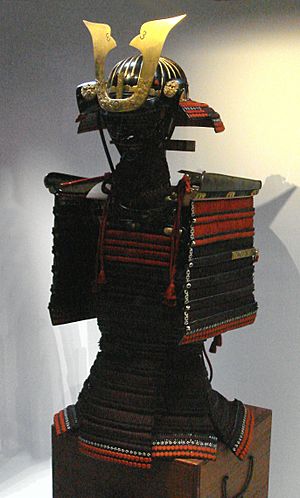
In 1613, English captain John Saris arrived in Hirado. He wanted to set up a trading factory for the British East India Company. The Dutch East India Company already had a big post there.
Adams refused to stay with the English. He lived with a Japanese official instead. The English noticed he wore Japanese clothes and spoke Japanese fluently. Adams thought the goods Saris brought were not very valuable in Japan.
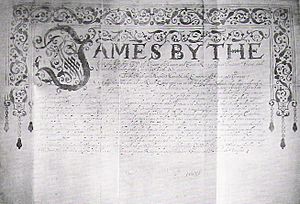
Adams traveled with Saris to meet Ieyasu. The English party then went to Kamakura to see the Great Buddha statue. They also met Ieyasu's son, Hidetada. Hidetada gave Saris two suits of armor for King James I. One of these suits is now in the Tower of London.
Tokugawa Ieyasu gave the English trading rights in Japan. He gave them a "Red Seal" permit. This allowed them to "abide, buy, sell and barter" freely.
Adams asked for permission to return to England. But he decided not to go with Saris. He said he wanted to earn more money first. He also had strong feelings against Saris. Adams then took a job with the new English trading factory in Hirado. He earned a good salary of 100 English Pounds a year. This was more than double what other workers earned.
Adams had advised Saris not to choose Hirado. It was small and far from the main markets in Osaka and Edo. Adams thought Uraga, near Edo, would be better. But Saris wanted to be close to the Dutch.
The English factory in Japan operated for ten years. Only three English ships came directly from London after the first one. Their goods were often not valuable in Japan.
Religious Conflicts
The Portuguese and other Catholic groups in Japan saw Adams as a rival. He was an English Protestant. As Adams became more powerful, the Jesuits tried to convert him. They even offered to secretly take him out of Japan on a Portuguese ship. This showed they feared his growing influence. Catholic priests said Adams was trying to make them look bad.
In 1614, a priest complained about Adams to the Pope. He said Adams and other merchants made them seem like spies. Ieyasu, influenced by Adams, expelled the Portuguese Jesuits from Japan in 1614. He also told Japanese Catholics to give up their faith. Adams also warned Ieyasu about the Spanish.
Asian Trade Journeys
Later in his life, Adams took part in many trade trips. He tried to organize a trip to find the legendary Northwest Passage. This would have made the journey between Japan and Europe much shorter.
Adams worked for the English East India Company. He made several trading voyages to Siam (modern-day Thailand) and Cochinchina (modern-day Vietnam). Sometimes he sailed for the company, and sometimes for himself. Japanese records show he owned a 500-ton Red Seal ship.
Since the English company sent few ships from England, Adams helped them get trading permits from the shōgun. This allowed the company to use the Red Seal system. They made seven trading trips to Southeast Asia. Four of these were led by William Adams as captain.
1614 Siam Trip
In 1614, Adams wanted to organize a trade trip to Siam. He bought and improved a 200-ton Japanese ship, renaming it Sea Adventure. He hired about 120 Japanese sailors and merchants. He also hired Chinese, Italian, and Spanish traders. The ship left in November 1614.
The trip was to buy raw silk, Chinese goods, wood, and animal skins. The ship carried silver and other goods like Indian cotton. The group faced a typhoon near the Ryukyu Islands (modern Okinawa). They had to stop there for repairs until May 1615. The ship returned to Japan in June 1615 without completing any trade.
1615 Siam Trip
Adams left Hirado in November 1615 for Siam again. He wanted to get sappan wood, which was very profitable. He carried silver and goods that had not sold on the last trip.
He bought large amounts of valuable products. His partners got two more ships in Siam to bring everything back to Japan. Adams sailed the Sea Adventure back to Japan with 143 tons of wood and 3,700 deer skins. The trip took only 47 days.
Just before Adams returned, Ieyasu had died. Adams met the new ruler, Hidetada. Hidetada agreed to continue the English trading rights. He also gave Adams a new Red Seal permit. This allowed Adams to keep trading overseas under the shōgun's protection. His position as hatamoto was also renewed.
Adams and Richard Cocks also visited the Japanese Admiral Mukai Shōgen. They talked about possibly invading the Catholic Philippines.
1617 Cochinchina Trip
In March 1617, Adams sailed to Cochinchina. He had bought the ship Sayers brought from Siam and renamed it the Gift of God. He wanted to find two English traders who had gone missing there. Adams learned that one had been killed for his silver. The other had drowned trying to escape.
Adams sold a small amount of goods in Cochinchina for a modest profit.
1618 Cochinchina Trip
In 1618, Adams led his last Red Seal trade trip to Cochinchina and Tonkin (modern Vietnam). This was the last trip for the English Hirado Factory to Southeast Asia. The ship left Hirado in March 1618 but faced bad weather. It had to return to Hirado in May.
These trips to Southeast Asia helped the English factory survive for a while. The wood they bought could be resold in Japan for a 200% profit. However, the factory eventually went bankrupt because of high costs.
Death and Family
William Adams died in Hirado, Japan, on May 16, 1620. He was 55 years old. He was buried in Nagasaki. In his will, he left his house in Edo, his land in Hemi, and 500 British pounds. This money was to be split evenly between his family in England and his family in Japan. Richard Cocks, the head of the Hirado factory, wrote that he was very sad to lose Adams. He said Adams was "in such favour with two Emperors of Japan as never any Christian in these part of the world."
Cocks stayed in touch with Adams' Japanese family. He sent them gifts. He also managed Adams' trading rights for Adams' children, Joseph and Susanna.
In England, Adams' daughter Deliverance married Raph Goodchild in 1618. They had two daughters. Deliverance later married again in 1624.
In 1623, the English trading factory in Hirado closed down because it was not making money. Joseph Adams inherited his father's title, Miura Anjin. He became a trader and made five trips to Cochinchina and Siam between 1624 and 1635.
By 1629, only two of Adams' shipmates from 1600 were still alive in Japan. They lived quietly in Nagasaki.
In 1635, the shōgun closed Japan to foreign trade. After this, Joseph and Susanna disappear from historical records.
Adams has a second memorial in Hemi, where he lived. It has two stone towers, one for Adams and one for his wife. His family built these memorials. The site became a National Historic Site in 1923.
Honors and Legacy
- A part of Edo (now Tokyo) was named Anjin-chō after Adams. This area is now called Nihonbashi Muromachi, but a street there is still named Anjin-dori.
- A village and a train station in his land, Hemi, were named after him.
- In Itō, Shizuoka, the Miura Anjin Festival is held every year on August 10. There is a monument to Adams by the sea in Itō.
- Adams' hometown, Gillingham, Medway, has held a Will Adams Festival every September since 2000. Itō and Yokosuka are now sister cities with Gillingham.
- A monument to Adams was put up in Gillingham, Kent, in 1934.
- A roundabout in Gillingham is named Will Adams Roundabout. It has roads named "Ito Way" and "Yokosuka Way" after the sister cities.
- William Adams' townhouse still exists in Hirado. It is now a sweet shop called Tsutaya. It is known as Anjin no Yakata (Anjin's House).
William Adams in Stories and Games
- The famous novel Shōgun (1975) by James Clavell is based on Adams' life. The main character is named "John Blackthorne." This book was made into a popular TV show in 1980.
- Many other books have been written about Adams, like Will Adams, The First Englishman in Japan (1861) and The Needlewatcher (1932).
- The book series Young Samurai is about a young English boy who is shipwrecked in Japan and trained as a samurai.
- William Adams is also the main character in the video game series Nioh (2017). In the game, he is an Irishman and has supernatural adventures.
Real Depictions
There is one real drawing of William Adams from his time. It is based on a sketch from a description given by Melchior von Santvoort. The original drawing is in the Rotterdam Maritime Museum. A copy is kept at the Bodleian Library at Oxford University.
Images for kids
-
Location of Annobón in the Gulf of Guinea
See also
 In Spanish: William Adams (marino) para niños
In Spanish: William Adams (marino) para niños




